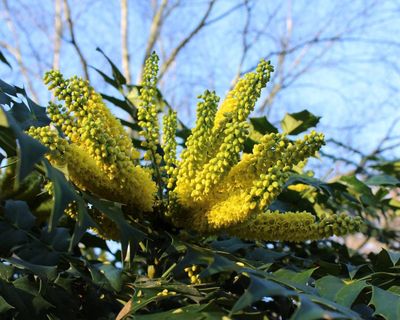Mahonia Information
Leatherleaf mahonia (Mahonia bealei) won’t resemble any other plants in your garden. They are small shrubs with sprays of dusty green leaves in curiously horizontal layers. The leaves look like holly plant leaves and are a bit spiny, like those of their relations, barberry shrubs. In fact, like barberries, they can make an effective defensive hedge if planted correctly. According to mahonia information, these plants bloom in winter or early spring, filling the branches with shoots of fragrant, butter-yellow blossom clusters. By summer the flowers develop into little round fruits, a surprising bright blue. They hang like grapes and attract all of the neighborhood birds. Before you start growing leatherleaf mahonia, take into account that these shrubs can get 8 feet (2 m.) tall. They thrive in USDA plant hardiness zones 7 through 9, where they are evergreen, retaining their leaves all year.
How to Grow a Leatherleaf Mahonia
Leatherleaf mahonia plants aren’t particularly difficult to grow and you’ll also find leatherleaf mahonia care a snap if the shrubs are installed in the right place. They appreciate shade and prefer a location with partial or full shade. Plant leatherleaf mahonia plants in acidic soil that is moist and well drained. Offer the shrubs wind protection as well, or else plant them in a wooded setting. Leatherleaf mahonia care includes ample irrigation after planting. Once you install the shrubs and start growing leatherleaf mahonia, you’ll need to give the plant ample water until its roots are established. After a year or so, the shrubs have a strong root system and are drought tolerant. Create a denser shrub by pruning back the tallest stems in early spring to encourage new growth at the base.
